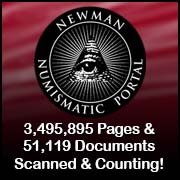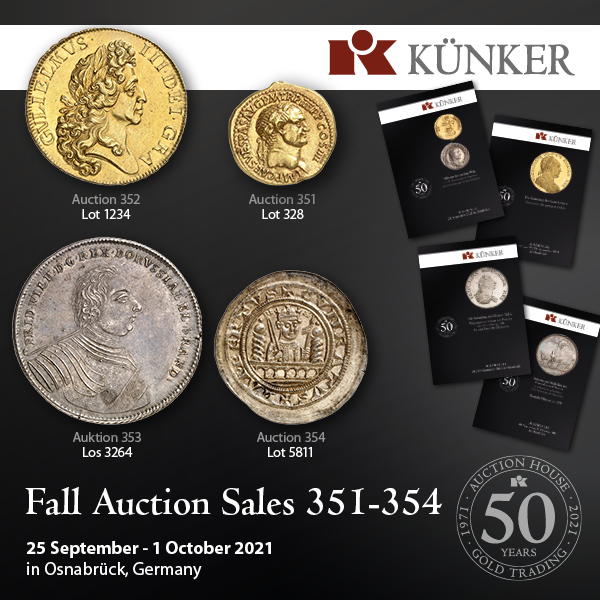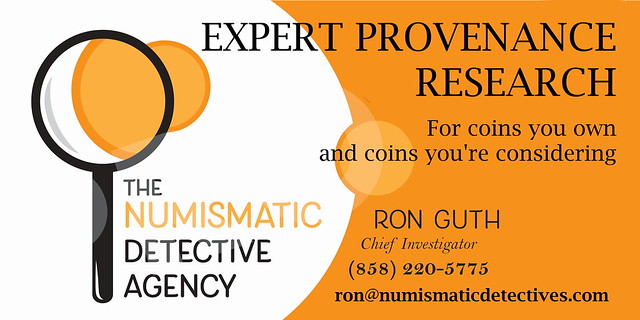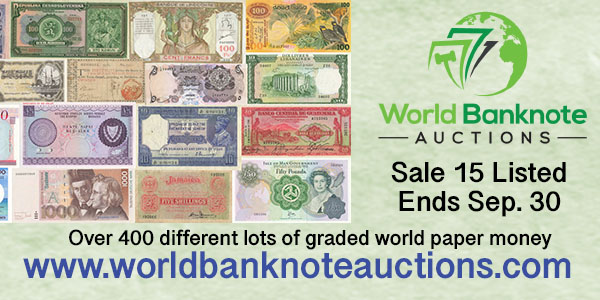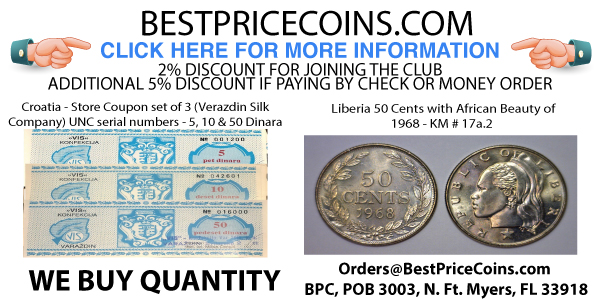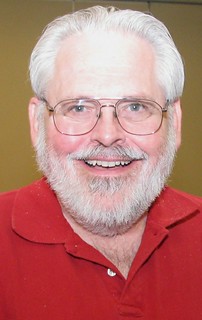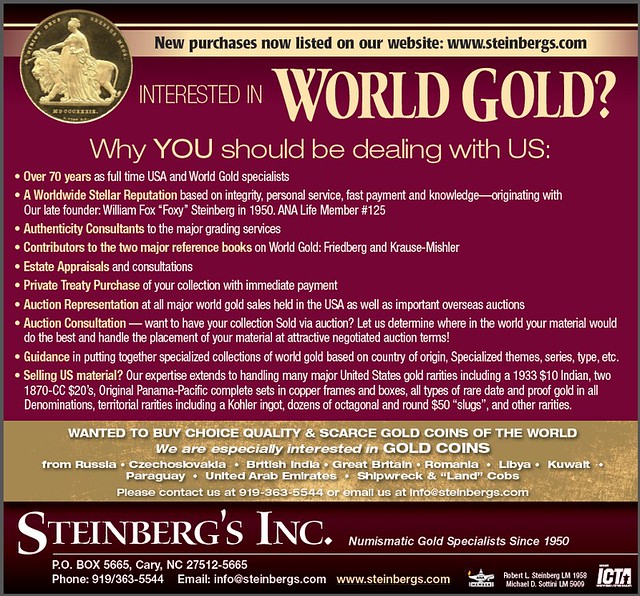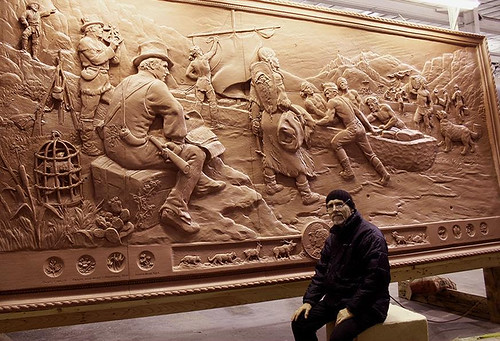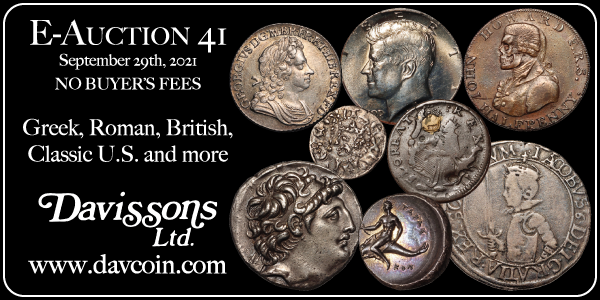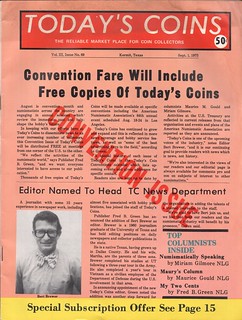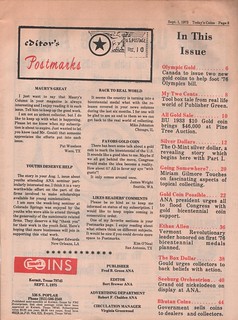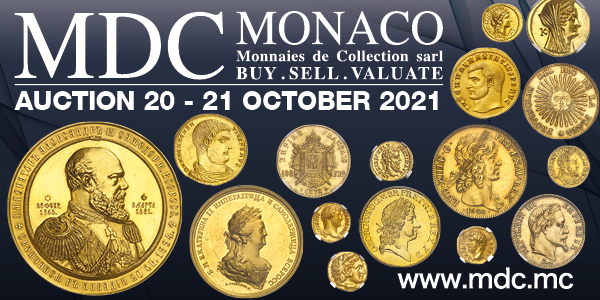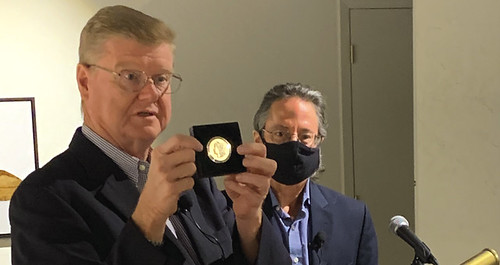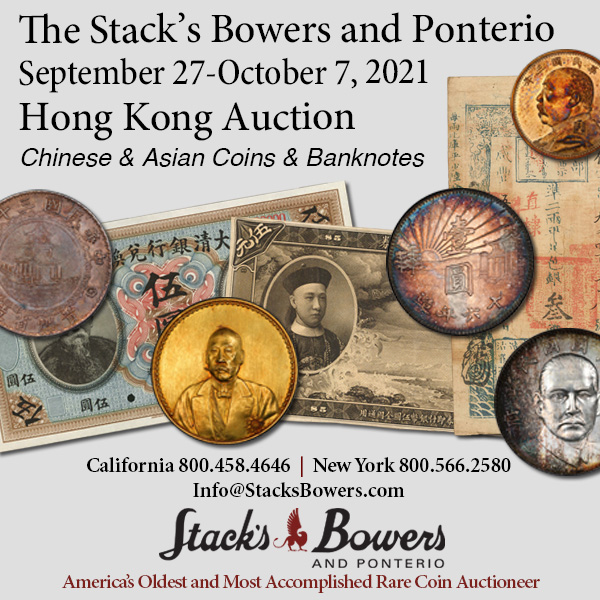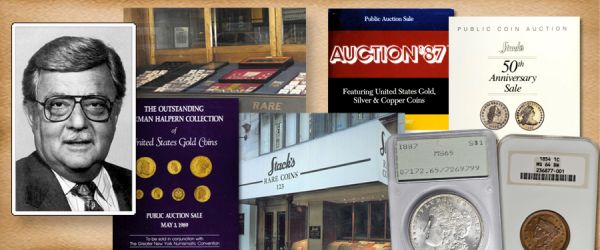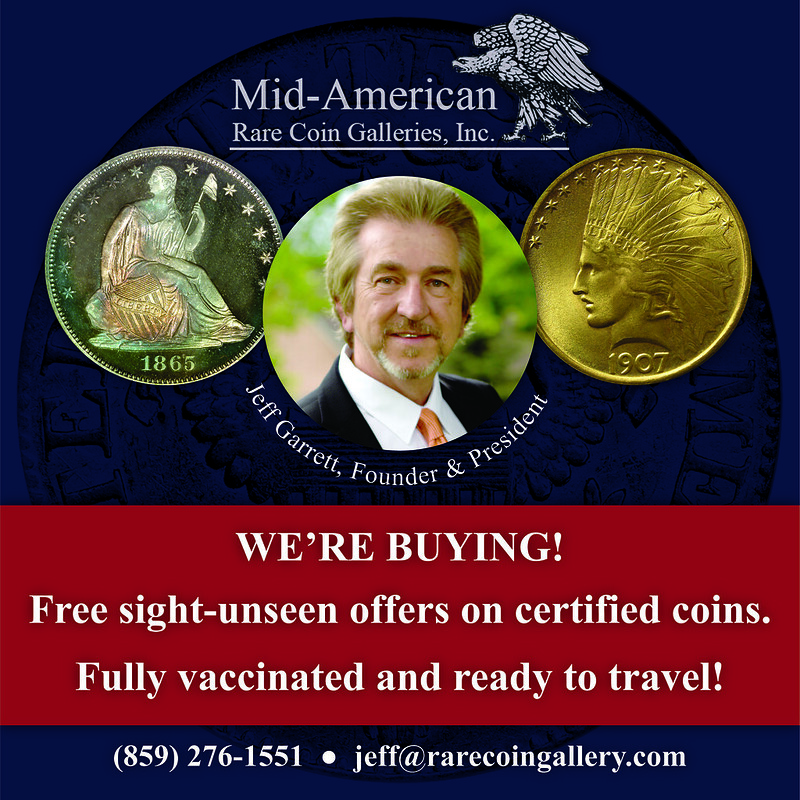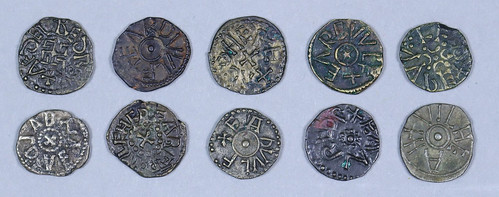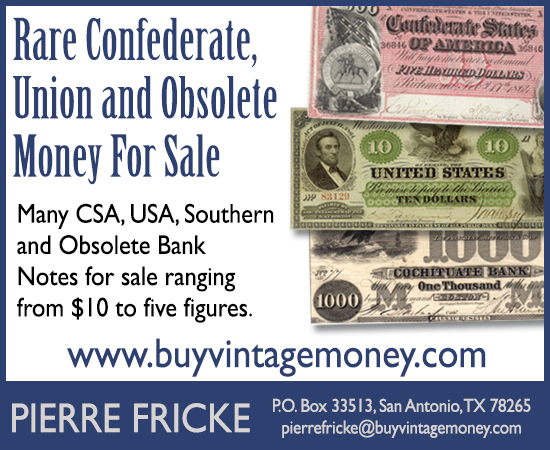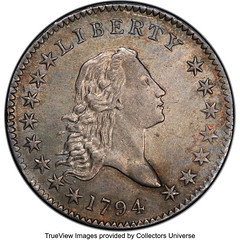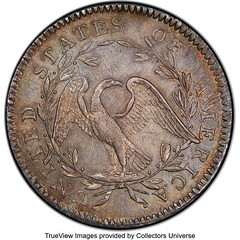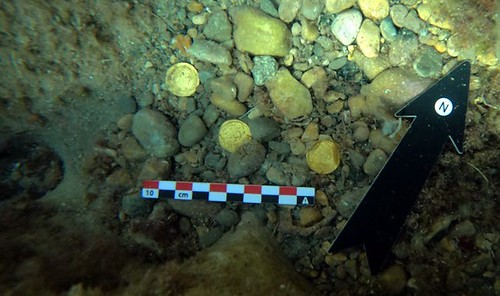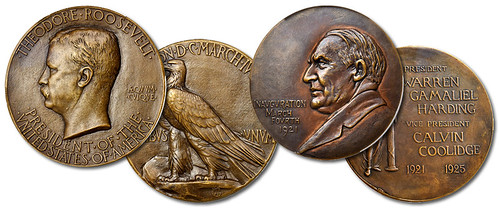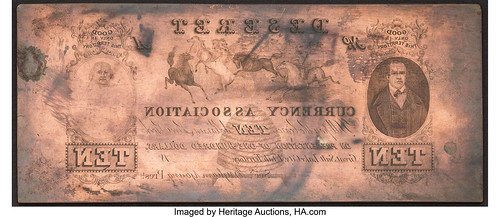
Visit our NBS Sponsors


About UsThe Numismatic Bibliomania Society is a non-profit association devoted to the study and enjoyment of numismatic literature. For more information please see our web site at coinbooks.org SubscriptionsThose wishing to become new E-Sylum subscribers (or wishing to Unsubscribe) can go to the following web page link MembershipThere is a membership application available on the web site Membership Application To join, print the application and return it with your check to the address printed on the application. Print/Digital membership is $40 to addresses in the U.S., and $60 elsewhere. A digital-only membership is available for $25. For those without web access, write to: Charles Heck, Treasurer AsylumFor Asylum mailing address changes and other membership questions, contact Chuck at this email address: treasurer@coinbooks.org SubmissionsTo submit items for publication in The E-Sylum, write to the Editor at this address: whomren@gmail.com BUY THE BOOK BEFORE THE COIN |
- WAYNE'S WORDS: THE E-SYLUM SEPTEMBER 26, 2021
- SALTON LIBRARY BRINGS RECORD PRICES
- NEW BOOK: 2022 CANADIAN COLLECTOR COINS
- NEW BOOK: MINT ERRORS TO DIE FOR, 2ND EDITION
- NEW BOOK: MUGHAL NUMISMATICS
- NEW SPANISH ONLINE RESOURCE: IMPERATRIX
- M. VERNON SHELDON ON THE 1913 LIBERTY NICKEL
- VIDEOS: FRED L. REED III
- MORE ON FRED L. REED III
- EUGENE DAUB RETROSPECTIVE
- REYMERSWAELE'S "TWO TAX COLLECTORS"
- NOTES FROM E-SYLUM READERS: SEPTEMBER 26, 2021
- PERIODICAL: TODAY'S COINS
- PEARSON: MORE DESIGNS FOR U.S. PAPER MONEY
- NEVADA MUSEUM RECEIVES 2021-CC DOLLAR
- DAVID RYDER RESIGNS AS MINT DIRECTOR
- ZERBE NAME REMOVED FROM ANA TOP AWARD
- ABOUT FARRAN ZERBE
- ANA SEEKS DONATIONS FOR INTERACTIVE EXHIBITS
- VOCABULARY TERM: FLATTENED RELIEF
- THE GRAND AND GREAT LADIES OF THE ANA
- HARVEY STACK'S NUMISMATIC FAMILY, PART 105
- DAVISSON E-AUCTION 41 HIGHLIGHTS
- JOHN CROSS COLLECTION OF ANGLO-SAXON COINS
- MORTON & EDEN OFFER SWEET TIN FIND
- NUMISMATIC NUGGETS: SEPTEMBER 26, 2021
- WAYNE'S NUMISMATIC DIARY: SEPTEMBER 26, 2021
- ROMAN GOLD COIN FIND NEAR SPAIN
- ROOSEVELT AND HARDING INAUGURAL MEDALS
- $10 DESERET CURRENCY PLATE OFFERED
Click here to read the thin version on the web
Click here to subscribe
Click here to access the complete archive
To comment or submit articles, reply to whomren@gmail.com
Content presented in The E-Sylum is not necessarily researched or independently fact-checked, and views expressed do not necessarily represent those of the Numismatic Bibliomania Society.
WAYNE'S WORDS: THE E-SYLUM SEPTEMBER 26, 2021
 New subscribers this week include:
Joe Cronin,
Rodney Merchant,
Mitresh Singh, and
Andrew Yates.
Welcome aboard! We now have 6,729 subscribers.
New subscribers this week include:
Joe Cronin,
Rodney Merchant,
Mitresh Singh, and
Andrew Yates.
Welcome aboard! We now have 6,729 subscribers.
Thank you for reading The E-Sylum. If you enjoy it, please send me the email addresses of friends you think may enjoy it as well and I'll send them a subscription. Contact me at whomren@gmail.com anytime regarding your subscription, or questions, comments or suggestions about our content.
This week we open with Salton library prices realized, three new books and a new online resource, updates from the Newman Numismatic Portal, a Eugene Daub retrospective, and more.
Other topics this week include Today's Coins, the 1913 Liberty Nickel, Fred Reed, Farran Zerbe, David Ryder, the Great Ladies of the ANA, flattened relief, auction previews, a Roman gold coin find, and inaugural medals.
To learn more about Corpus Nummorum Italicorum, mint errors, Mughal numismatics, the Two Tax Collectors, satirical banknotes, rilievo schiacciato, the Tubman $25 bill, the Empire of Brazil, the John Cross Collection, the gold Thrymsa, and the New England Shilling found in a candy box, read on. Have a great week, everyone!
Wayne Homren
Editor, The E-Sylum
SALTON LIBRARY BRINGS RECORD PRICES
Here's a report on prices realized in the recent Kolbe & Fanning sale of the Salton library. Wow! -Editor
Kolbe & Fanning Numismatic Booksellers, in cooperation with Fritz Rudolf Künker, sold the numismatic library of Mark and Lottie Salton on Saturday, September 18. The sale received widespread attention from bidders around the world, and brought exceptional results, with over 95% of the lots selling.
Some highlights of the sale included:
NEW BOOK: 2022 CANADIAN COLLECTOR COINS
A new edition of the book on modern Royal Canadian Mint collector issues has been published. -Editor
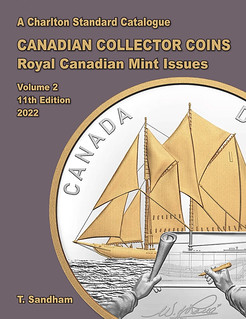 CHARLTON 2022 CANADIAN COLLECTOR COINS, ROYAL CANADIAN MINT ISSUES
CHARLTON 2022 CANADIAN COLLECTOR COINS, ROYAL CANADIAN MINT ISSUES
$46.95
VOLUME TWO, 11TH EDITION, 2022 – available in English and French
Todd Sandham, Editor
640 pages
ISBN: 978-0-88968-429-4 (ENGLISH) – 978-0-88968-430-0 (FRENCH)
The 11th edition, Volume Two is the leading authoritative catalogue on the Royal Canadian Mint collector issues on the market today. Our catalogue references virtually all of the non-circulating legal tender issues ever released by the Royal Canadian Mint since the 1950s!
NEW BOOK: MINT ERRORS TO DIE FOR, 2ND EDITION
Author Joe Cronin passed along this information about the second edition of his book on error coins. Thanks. -Editor
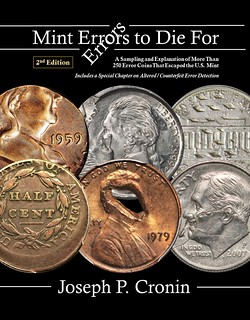 This fascinating and much-needed numismatic resource, now in its 2nd edition, is a large, 340+ page coffee-table book (8.5 by 11 inches) loaded with big HD color photos. It is written in plain language and is great for beginners, yet is extensive and detailed enough for the advanced collector.
This fascinating and much-needed numismatic resource, now in its 2nd edition, is a large, 340+ page coffee-table book (8.5 by 11 inches) loaded with big HD color photos. It is written in plain language and is great for beginners, yet is extensive and detailed enough for the advanced collector.
Learn about dozens of error types, error vocabulary, how errors occur, how to assess values, tips for error collecting, and there is even a special chapter on how to tell if a coin is damaged, altered, or counterfeit and merely appears as a genuine Mint error.
This book is a great investment to help you avoid buying all the junk out there posing as real errors, and can also help you cherry-pick a great error a seller didn't catch. Save time, money, and aggravation as you acquire errors for your collection or for sale. Get your copy today!
NEW BOOK: MUGHAL NUMISMATICS
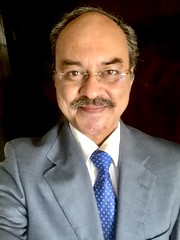 Mitresh Singh of India writes:
Mitresh Singh of India writes:
"I have recently authored my maiden book on Mughal Numismatics subtitled "Revisiting Rarities: New Perspectives & Fresh Approach". The book is published by the Indian Coin Society (ICS), a registered non-profit, and was released recently on 28 Aug 2021."
Here's an excerpt from the announcement on Facebook. Follow the link below for more information. -Editor
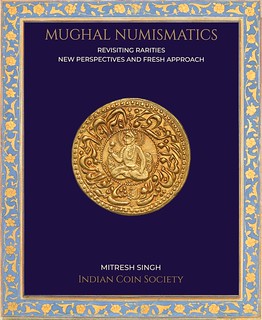 The book has been printed and financed under the Prem Ratan Maru Fellowship of Marudhar Arts and this is the first book under such scholarship. The printing quality of the book is excellent with clear high resolution images and crisp text.
The book has been printed and financed under the Prem Ratan Maru Fellowship of Marudhar Arts and this is the first book under such scholarship. The printing quality of the book is excellent with clear high resolution images and crisp text.
The books USP / salient features is as below:
- Length: 280mm / 28cm / 11 inch
- Breadth: 216mm/ 21.6cm / 8.50 inch
- Thickness: 10mm / 1 cm / 0.4 inch
- No. of pages: 226 (cover to cover)
- Edition: Paperback with thick front & back cover
NEW SPANISH ONLINE RESOURCE: IMPERATRIX
Robert Hoge writes:
"The Spanish Numismatic Association (the redoubtable ANE -- Asociación Numismática Española -- headquartered in Barcelona) has recently launched under its auspices, with the support of the well-known firm of Aureo & Calicó, an on-line catalogue of all the Medieval coins of the Kingdom of Castile and Leon, based upon the three-volume encyclopedia compiled by Manuel Mozo Monroy. It is called Imperatrix."
M. VERNON SHELDON ON THE 1913 LIBERTY NICKEL
The latest additions to the Newman Numismatic Portal include Eric Newman's notes on the 1913 Liberty nickel. Project Coordinator Len Augsburger provided the following report. Thanks. -Editor
M. Vernon Sheldon on the 1913 Liberty Nickel
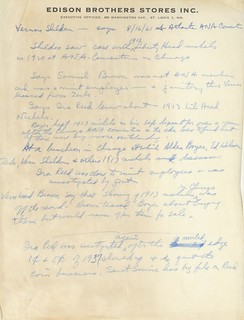 Few collectors have time during a busy coin convention to take notes on the recollections of the day. Dealers have even less, and most are just happy to keep their accounting and inventory records up to date with the day's trading. Eric Newman was an exception, recording his recollections of a discussion with Vernon Sheldon at the 1961 ANA convention in Atlanta. To set the scene, this memo was written the evening before Newman delivered one of the most anticipated speeches in ANA convention history, on a completely unrelated subject – the 1804 dollar. Newman and Ken Bressett's work was groundbreaking, and much of what is considered common knowledge today was first revealed during this presentation. But Newman was ever in information collecting mode, as demonstrated by his notes from the Sheldon conversation.
Few collectors have time during a busy coin convention to take notes on the recollections of the day. Dealers have even less, and most are just happy to keep their accounting and inventory records up to date with the day's trading. Eric Newman was an exception, recording his recollections of a discussion with Vernon Sheldon at the 1961 ANA convention in Atlanta. To set the scene, this memo was written the evening before Newman delivered one of the most anticipated speeches in ANA convention history, on a completely unrelated subject – the 1804 dollar. Newman and Ken Bressett's work was groundbreaking, and much of what is considered common knowledge today was first revealed during this presentation. But Newman was ever in information collecting mode, as demonstrated by his notes from the Sheldon conversation.
VIDEOS: FRED L. REED III
These are selections from the David Lisot Video Library that feature news and personalities from the world of coin collecting. David has been attending coin conventions since 1972 and began videotaping in 1985. The Newman Numismatic Portal now lists all David's videos on their website at:
https://nnp.wustl.edu/library/multimediadetail/522852
"Here are two videos on the Portal that feature Fred. He was a consummate researcher and great speaker. He will be missed."
Thanks! -Editor
MORE ON FRED L. REED III
The family of Fred Reed has posted a memoriam online with more information and photos. I've included two here - Fred in 2018 in an Abe Lincoln T-shirt, and another with his daughter Becky at a coin event. Thanks to Len Augsburger for passing the link along from the Central States Facebook group. -Editor
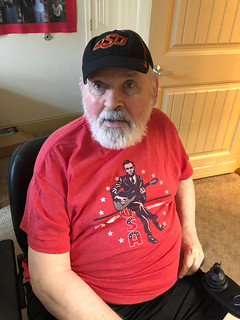 Fred Leslie Reed, III, woke walking and talking once again, swinging his arms and snapping his fingers (the way he had done when he was happy) fully restored, in Heaven on 24 July, 2021. He had lived patiently and graciously while severely disabled near his daughter's family in Dallas, TX, following a life-altering massive stroke in 2013 when he suffered this final stroke.
Fred Leslie Reed, III, woke walking and talking once again, swinging his arms and snapping his fingers (the way he had done when he was happy) fully restored, in Heaven on 24 July, 2021. He had lived patiently and graciously while severely disabled near his daughter's family in Dallas, TX, following a life-altering massive stroke in 2013 when he suffered this final stroke.
Fred was born 21 Jan, 1948, to Fred Jr. and Maria Mühlthaler in Syracuse, NY, where his grandfather, Fred Sr. was mayor and owned Reed's Bowling Alley and Reed's Esso Station. Fred's parents had met during WW2 while Fred Jr. served in the U.S. Army (England, France, and Munich). Maria had been drafted into the Nazi army but had escaped with her life after intentionally sabotaging the parachutes she was ordered to fold. The mayor of her town, Pfarrkirchen, Germany, intervened and arranged for her to clean the housing where the American soldiers were stationed, and thus began their love story. Although Fred Jr.'s family was Baptist, he deferred to Maria's Catholic background in bringing up Fred III and his younger brother, Michael.
EUGENE DAUB RETROSPECTIVE
The work of sculptor and medal designer Eugene Daub is featured in a retrospective at the Palos Verdes Art Center. -Editor
Palos Verdes Art Center / Beverly G. Alpay Center for Arts Education has announced Eugene Daub: Monumental, a retrospective of the internationally acclaimed sculptor's large public works. This exhibition will offer a behind-the-scenes view into the creation of monumental sculptures – starting from the sketch to a maquette, the enlargement, the mold-making process, and finally the pouring of the bronze and welding it all back together again from many pieces.
Among the 12 of Daub's monumental works chronicled by this exhibition are Lewis & Clark, Kansas City, Missouri; Rosa Parks, US Capitol, Washington, D.C.; Harry Bridges, ILWU Union Hall, Wilmington, CA; Thomas Jefferson, University of Virginia, and Phineas Banning, Banning's Landing, Wilmington.
REYMERSWAELE'S "TWO TAX COLLECTORS"
Steve Roach writes:
"You featured one of my favorite paintings! There's currently a version of it on loan at the ANA Money Museum. I've attached some photos in its current display in the lower level gallery. What's really interesting about it is how specific the artist was in depicting money (along with the great 19th century giltwood and gesso frame!). "
Who knew? Not me! Thanks so much for letting us know. Steve sent some great photos. -Editor
THE BOOK BAZARRE
NOTES FROM E-SYLUM READERS: SEPTEMBER 26, 2021
Coin World Weekly Print Edition
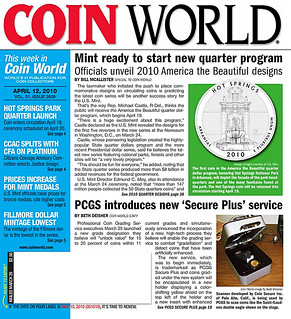 Tom Caldwell writes:
Tom Caldwell writes:
"Coin World still is indeed still a weekly. Monthly it is a more robust publication & the other weeks quite the slimmed down version. I believe subscribers can go for 12 issues annually or 52."
Tom was reacting to a comment by Tom DeLorey about the publication of Coin World in print. Those of us living in the online world can lose track of these things, but Tom C. is right - Coin World does still publish a weekly paper and ink issue. Thanks. -Editor
To read the earlier E-Sylum article, see:
NUMISMATIC SCRAPBOOK CONTRIBUTOR TOKENS
(https://www.coinbooks.org/v24/esylum_v24n37a14.html)
Other topics this week include the Muera Huerta notes, and satirical banknotes. -Editor
PERIODICAL: TODAY'S COINS
Dave Lange submitted this note on an obscure numismatic periodical. Thank you! -Editor
In researching coin folders and albums I've found that some of the best sources are the commercial numismatic publications that flourished in the 1950s-70s. I always buy old issues of COINS and COINage when I can get them at a reasonable price, since these are not yet viewable in their entirety at the Newman Numismatic Portal.
PEARSON: MORE DESIGNS FOR U.S. PAPER MONEY
Wayne Pearson passed along these additional design ideas for U.S. paper money. Thanks. -Editor
NEVADA MUSEUM RECEIVES 2021-CC DOLLAR
Coin World reported that the Nevada State Museum has received an example of the new 2021-CC Morgan dollar. Here's an excerpt - see the complete article online. -Editor
A privy-marked 2021-CC Morgan dollar struck at the Philadelphia Mint was formally presented Sept. 14 to the Nevada State Museum in-person by Rep. Mark E. Amodei, R-Nev. The museum is located in the former Carson City Mint building.
U.S. Mint Director David J. Ryder participated in the Sept. 14 presentation virtually via videoconferencing.
The coin presented by Amodei to the Nevada State Museum is the example he struck at the Philadelphia Mint on July 19, said U.S. Mint spokesman Michael White.
Amodei presented the coin to the museum on behalf of the Mint. The coin was not one of the first strikes, White said.
DAVID RYDER RESIGNS AS MINT DIRECTOR
The gift to the Nevada State Museum was one of David Ryder's last acts as Mint Director. In a September 24th press release, the Mint announced his resignation. -Editor
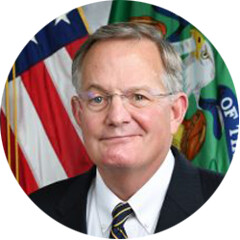 Today, the U.S. Department of the Treasury announced Alison Doone as the new Acting Director of the U.S. Mint. Doone previously served as Chief Administrative Officer at the Mint. Doone's first day as Acting Director will be on October 1 as Director David J. Ryder leaves the bureau to pursue new opportunities.
Today, the U.S. Department of the Treasury announced Alison Doone as the new Acting Director of the U.S. Mint. Doone previously served as Chief Administrative Officer at the Mint. Doone's first day as Acting Director will be on October 1 as Director David J. Ryder leaves the bureau to pursue new opportunities.
I'm excited to serve the U.S. Mint as Acting Director to help it continue its important work,
said Alison Doone. I look forward to working alongside the devoted Mint employees across the country and supporting our ongoing efforts to ensure that we are operating efficiently and producing quality products for the American people.
ZERBE NAME REMOVED FROM ANA TOP AWARD
In another sudden announcement, the American Numismatic Association issued a press release this week announcing a name change for its top award. -Editor
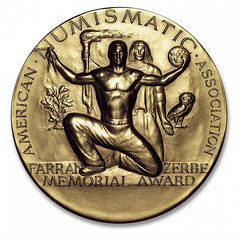 During an open session meeting on January 19, 2021, the ANA Board of Governors honored the wishes of nearly 20 past Farran Zerbe Memorial Award winners by voting to remove Zerbe's name from the ANA's highest honor after the 2021 presentation (its 70th year). According to the motion, the accolade will be called the Distinguished Service Award "until such time as the name of an exemplary, deceased ANA member be brought forward to the Board, after vetting by the Awards Committee, for consideration of formal approval with proper funding arrangements for such naming rights."
During an open session meeting on January 19, 2021, the ANA Board of Governors honored the wishes of nearly 20 past Farran Zerbe Memorial Award winners by voting to remove Zerbe's name from the ANA's highest honor after the 2021 presentation (its 70th year). According to the motion, the accolade will be called the Distinguished Service Award "until such time as the name of an exemplary, deceased ANA member be brought forward to the Board, after vetting by the Awards Committee, for consideration of formal approval with proper funding arrangements for such naming rights."
ABOUT FARRAN ZERBE
At my request American Numismatic Biographies author Pete Smith kindly provided this summary of the Zerbe controversies. -Editor
I was not surprised to learn that the ANA was removing the name of Farran Zerbe from their highest award. I looked through The American Numismatic Association Centennial History (1991) to refresh my memory.
The 1909 presidential election was hotly contested. The outgoing president, Farran Zerbe, supported his vice president, Dr. J. M. Henderson, in the election. The opposing candidate was Frank C. Higgins who was supported by dealer Thomas L. Elder.
ANA SEEKS DONATIONS FOR INTERACTIVE EXHIBITS
On a different topic, the ANA is seeking donations to help create new interactive exhibits for young museum visitors. -Editor
 The American Numismatic Association's Money Museum in Colorado Springs, Colo., attracts thousands of families and children each year to its popular Kids Zone. To create more inspiring learning experiences, museums are turning to
The American Numismatic Association's Money Museum in Colorado Springs, Colo., attracts thousands of families and children each year to its popular Kids Zone. To create more inspiring learning experiences, museums are turning to smart
technology tools that enable more interactive educational experiences to help leverage content.
These tools can expand the Museum's ability to offer games, videos and activities curated especially for young visitors and families. The interactive touch screen would be used during structured Kids Zone activities and independently by museum patrons during public hours. (Interactive touch screens are in use in classrooms across the country, and many school children are already familiar with how to use them.)
VOCABULARY TERM: FLATTENED RELIEF
Here's another entry from Dick Johnson's Encyclopedia of Coin and Medal Terminology. -Editor
Flattened Relief. Low relief, or very low relief (as coin relief or stiacciato). A somewhat imprecise term, as the relief is not flattened but purposefully modeled that way in very low relief. Perhaps the first to develop a style of such low relief was Donatello (1386?-1466), the Florentine sculptor who broke with classicism to employ a more realistic depiction of his subjects. He is considered the founder of modern sculpture, and widely used low relief, which he termed rilievo schiacciato (roughly translated as flattened relief). It is this very low relief that is necessary for coin models so that dies made from these models can strike a coin in a single blow.
THE GRAND AND GREAT LADIES OF THE ANA
Pete Smith submitted this follow-up to last week's topic about the "Great Ladies" of the ANA. -Editor
Faye C. Rochette died on August 4, 1977. In her memory, the ANA established the Faye C. Rochette Memorial Fund. Geneva Karlson proposed the funding of an award for a Grand Lady of the ANA. Later, on August 28, 1977, the ANA Board adopted the proposal as the Faye C. Rochette Great Lady of the ANA Memorial Award. It was to be give to someone who was a member of the ANA but not an officer.
The award was presented eight times.
HARVEY STACK'S NUMISMATIC FAMILY, PART 105
The latest article in Harvey Stack's blog series covers a 1989 debate over the licensing of professional coin dealers. -Editor
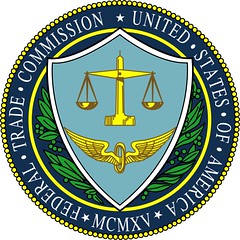 As noted earlier, in May 1989 I took part in a debate with the Federal Trade Commission (FTC) on the merits of their plan to require licensing of professional coin dealers. This debate was held at the Metropolitan New York Convention. Each side presented its case. Barry Cutler, the Director of the Federal Trade Commission (FTC) led off the discussions stating that U.S. coins were being counterfeited and sold as authentic and that there were Investment Funds that sold gold to clients at a low premium, stored them "free of charge," but did not ever deliver them to the buyer.
As noted earlier, in May 1989 I took part in a debate with the Federal Trade Commission (FTC) on the merits of their plan to require licensing of professional coin dealers. This debate was held at the Metropolitan New York Convention. Each side presented its case. Barry Cutler, the Director of the Federal Trade Commission (FTC) led off the discussions stating that U.S. coins were being counterfeited and sold as authentic and that there were Investment Funds that sold gold to clients at a low premium, stored them "free of charge," but did not ever deliver them to the buyer.
There were all kinds of scams, including instructing people to not open coin rolls or mint-sealed boxes or bags, as that would reduce the value. In this way customers could be ripped off by the inclusion of fake or low-grade coins that were only discovered if the roll or bag was opened. These were all concerns of the FTC, the Treasury Department/Secret Service, and the Security and Exchange Commission (SEC). From 1985 through 1989 the FTC apprehended some of these scam artists, arrested them, brought them to trial and fined them huge sums.
DAVISSON E-AUCTION 41 HIGHLIGHTS
The Davisson's E-Auction 41 closes this week. Here are some articles they published recently via client emails showcasing some sale highlights.
For more information, see:
https://davcoin.com/
.
-Editor
Ancient Coinage
Fall is upon us! Now is the time of year when we all wonder "where did summer go" and "how are we already halfway through September?"
The auction calendar is similarly inexorable–E-Auction 41 has just two weeks to go! Bidding closes on Wednesday, September 29th. This auction is particularly diverse, with significant sections devoted to World and U.S. in addition to our usual Ancient and British offerings. Below we look at a few notable lots in the Greek and Roman sections.
JOHN CROSS COLLECTION OF ANGLO-SAXON COINS
David Pickup passed along this article about the John Cross Collection of Anglo-Saxon Coins offered by the Canterbury Auction Galleries. Thanks. -Editor
When the executors began clearing the contents of a Canterbury pensioner's park home following his death last year, they discovered he had quietly amassed a sizeable collection of early Anglo-Saxon coins so valuable they were kept in a bank vault for safekeeping. When they were examined by the numismatic consultant at The Canterbury Auction Galleries, he described them as among the most important collection of Anglo-Saxon coins outside any UK museum.
MORTON & EDEN OFFER SWEET TIN FIND
How many times have we heard the tale of rare coins found in an old tin can or box? Here's the latest in a press release from Morton & Eden. -Editor
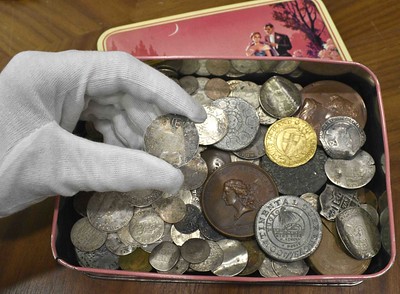 An extremely rare example of a mid 17th century New England shilling, one of the very first coins to have been struck in North America, has recently been discovered in an old sweet tin. It is due to be auctioned online on Friday 26 November by specialist auctioneers Morton & Eden in London, when it is estimated to fetch £60,000-80,000.
An extremely rare example of a mid 17th century New England shilling, one of the very first coins to have been struck in North America, has recently been discovered in an old sweet tin. It is due to be auctioned online on Friday 26 November by specialist auctioneers Morton & Eden in London, when it is estimated to fetch £60,000-80,000.
The coin was identified by coin specialist James Morton, who recounts; There were several hundred coins in the old Barker & Dobson sweet tin. The coins were completely varied, from all over the world and in all metals, ranging in date from medieval times right up to the 1970s. I could see straight away that there were plenty of interesting pieces alongside some ordinary modern coins, but there was one simple silver disc, which immediately jumped out at me. I could hardly believe my eyes when I realised that it was an excellent example of a New England shilling, struck by John Hull in 1652 for use as currency by early settlers in the Massachusetts Bay Colony.
THE BOOK BAZARRE
NUMISMATIC NUGGETS: SEPTEMBER 26, 2021
Here's a selection of interesting or unusual items I came across in the marketplace this week. Tell us what you think of some of these. -Editor
The half dollar proved to be an acceptable alternative to silver dollars. Researchers have differing opinions about exactly how many 1794 half dollars were struck, but the prevailing consensus (based on Mint delivery warrants) suggests 5,300 1794 half dollars were delivered in December 1794 and 18,464 half dollars dated 1794 were delivered on February 4, 1795 for a total of 23,464 pieces struck. A survival rate between 3% and 4% -- typical for early Mint issues -- further supports the estimated mintage. Approximately 800 1794 half dollars are thought to survive, including all grades and varieties.
Flowing Hair half dollars circulated extensively. They were a "blue collar" coin -- less spectacular than the silver dollars, but often the preferred denomination in commerce. For today's collectors, 1794 half dollars offer a relatively affordable alternative to the rare and expensive 1794 dollars, although no one would turn down an opportunity to have both. In relation to their mintage, 1794 half dollars are far rarer in high grades than their dollar counterparts, and they are equally rare in terms of the sheer number of high-grade survivors (AU and finer). Uncirculated 1794 half dollars are great rarities, with just 9 Mint State pieces reported by PCGS and NGC combined.
A nice coin from the Heritage October Long Beach sale. -Editor
To read the complete lot description, see:
1794 50C O-105, T-3, High R.4, AU58+ PCGS....
(https://coins.ha.com/itm/early-half-dollars/half-dollars/1794-50c-o-105-t-3-high-r4-au58-pcgs-pcgs-39206-/a/1334-3507.s)
Other topics this week include the Merriam Die Sinker token, J. Douglas Ferguson Award medal, and a Martin Van Buren bank check. -Editor
WAYNE'S NUMISMATIC DIARY: SEPTEMBER 26, 2021
Tuesday September 21, 2021 was the night of my Northern Virginia numismatic social group, Nummis Nova. Wayne Herndon was our host at the French restaurant Mon Ami Gabi in Reston Town Center. Chris Neuzil was already seated at our table when I arrived. We were soon joined by Jon Radel, Roger Burdette, Wayne himself and finally Julian Leidman. It was a small turnout, but made for a great discussion forum.
As a social group our discussions are not just numismatic, and we learned about family members, Chris' fender-bender, multiple facts and opinions about the ongoing pandemic, and Roger's dreams. Roger described a dream that could be classified in the modern category of "electric vehicle range anxiety", wherein he kept being frustrated in attempts to recharge and get to his final destination. He explained that he often writes down dreams to provide his acting-student daughter ideas for skits and plays. When someone questioned the usability of the premise, I said, "You could name it 'Waiting for Rogot'..."
ROMAN GOLD COIN FIND NEAR SPAIN
Arthur Shippee and Peter Huntoon passed along this article about a find of Roman gold coins near Spain. Thanks. -Editor
Freedivers off the coast of Spain have uncovered a treasure trove of 53 perfectly preserved gold coins from the Roman Empire, one of the largest collections ever found in Europe.
ROOSEVELT AND HARDING INAUGURAL MEDALS
Stack's Bowers' Director of Consignments and Numismatics James McCartney published a blog article about two rare inaugural medals coming up for sale in the firm's November 2021 Whitman Coin Expo sale. -Editor
Stack's Bowers Galleries is thrilled to present some of the most famous and elusive United States Inaugural bronze medals in our official auction for the Whitman Coin & Collectibles Winter Expo in November. Highlighted by an incredible Gem SP-65 (PCGS) 1905 Roosevelt medal and an Uncirculated SP-62 (PCGS) 1921 Harding medal, this will be one of the most important offerings from this series in recent years.
$10 DESERET CURRENCY PLATE OFFERED
In February we discussed the discovery of an engraving plate for a previously unknown $10 Deseret Currency Association note. The plate is being offered by Heritage Auctions in their October 2021 Long Beach sale. What a great centerpiece for a collection of Mormon currency! -Editor
Salt Lake City, UT- Deseret Currency Association Copper Printing Plate for Unknown $10 Denomination 18__ "As Made" condition. We are honored to be offering a ground breaking and historic piece of numismatic and Mormon history this evening. The item being offered is the original copper printing plate which was intended to be used to print a $10 denomination as part of the Deseret Currency Association (DCA) issue. The DCA was formed in January 1858 to provide currency for use in commerce in an area that was almost totally without other types of currency. Prior to the issue of the DCA notes, all that was available was a minimal amount of U.S. coins, an equally small issue of Mormon gold coins, and a few reissued earlier Mormon bank notes.
Early DCA notes were simple, hastily printed designs and comprised denominations including $1, $2, $3, $5, $10, $20, $50 and $100. Nearly $67,000 of these first series notes were printed by the spring of 1858 in Salt Lake City and Fillmore. According to noted expert Douglas Nyholm, only $1s and $2s along with a single $3 are known from this first series at present.

